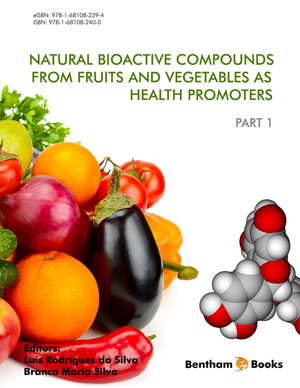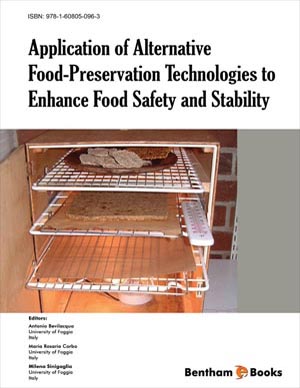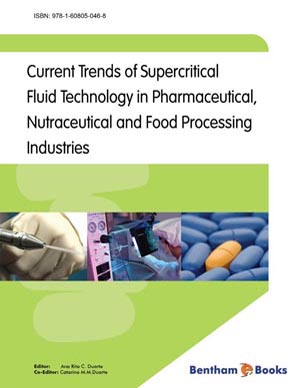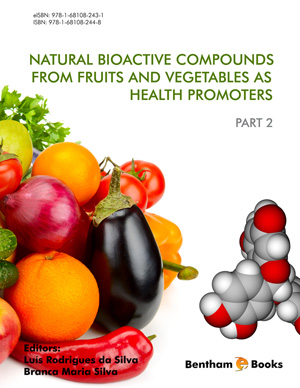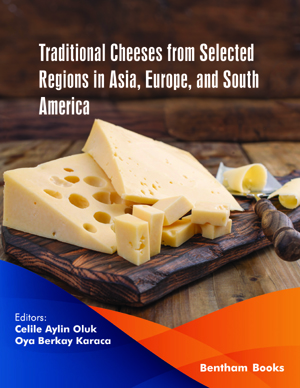Foreword
Page: i-ii (2)
Author: Jose Alberto Pereira and Susana Casal
DOI: 10.2174/9781681082394116010001
Preface
Page: iii-iii (1)
Author: Luis Rodrigues da Silva and Branca Silva
DOI: 10.2174/9781681082394116010002
List of Contributors
Page: iv-vi (3)
Author: Luis Rodrigues da Silva and Branca Silva
DOI: 10.2174/9781681082394116010003
Bioactive Compounds and Health-Promoting Properties of Ficus carica (L.): A Review
Page: 3-28 (26)
Author: Ana R. Nunes, Marco G. Alves, Pedro F. Oliveira, Luis R. Silva and Branca M. Silva
DOI: 10.2174/9781681082394116010004
PDF Price: $30
Abstract
Ficus carica (L.), also known as fig, is a deciduous tree belonging to the Moraceae family, and was one of the first plants cultivated. Figs, F. carica fruits, are an important component of the Mediterranean diet and can be consumed either fresh or dried, or used for jam production. Notably, this fruit has a great economic importance in many countries, including Portugal, due to its nutritional value and medicinal properties. This botanical species is a good and low cost natural source of bioactive compounds, such as organic acids, phenolic compounds, minerals, amino acids, fibers and others. Several biological activities of F. carica have been reported illustrating a high beneficial health potential for this species. In this chapter, we will discuss the phytochemical composition, nutritional value and biological activities of F. carica, particularly the leaf, fruit and latex. The potential use of F. carica to prevent and treat a wide range of diseases will also be discussed. This natural product may be a promising candidate for the development of new nutraceuticals and food supplements. However, despite the advances in phytomedicine area, the molecular mechanisms by which fig derivatives contribute to health improvement remain largely unknown.
Bioactive Compounds of Citrus as Health Promoters
Page: 29-97 (69)
Author: Amilcar Duarte, Catarina Carvalho and Graca Miguel
DOI: 10.2174/9781681082394116010005
PDF Price: $30
Abstract
Citrus are a group of fruit species, quite heterogeneous in many aspects, including chemical composition of the fruit. Since ancient times, some citrus fruits were used to prevent and cure human diseases. In the recent decades, it has been demonstrated that fruits can actually help prevent and cure some diseases and above all, they are essential in a balanced diet. Citrus fruits, as one of the groups of fruit species, with greater importance in the world, have been studied for their effects on human health. Some species of citrus were referred as potential antioxidant based therapy for heart disease, cancer and inflammation. Fruit peels and seeds have also high antioxidant activity. The health benefits of citrus fruit have mainly been attributed to the high level of bioactive compounds, such as phenols (e.g., flavanone glycosides, hydroxycinnamic acids), carotenoids and vitamin C. These compounds are present in the fruit pulp and hence in the juice. But some bioactive compounds can be found in parts of the fruit which usually are not used for human food. The content of bioactive compounds depends on the species and cultivar, but also depends on the production system followed in the orchard. Citrus fruits, their derivatives and their by-products (peel, pulp and oil) are reach in different bioactive compounds and its maturity, postharvest and agroindustry processes influence their composition and concentration. The aim of this chapter was to review the main bioactive compounds of the different components of citrus and their relationship to health.
Bioactive Compounds of Apples and Pears as Health Promoters
Page: 98-109 (12)
Author: Andrea Catalina Galvis-Sánchez and Ada Rocha
DOI: 10.2174/9781681082394116010006
PDF Price: $30
Abstract
Contemporaneous dietary patterns could be best described as in need of improvement. Obesity, diabetes and metabolic syndrome prevalence increased dramatically in the recent years likely due to unbalanced dietary patterns and sedentary lifestyle. “Epidemiological studies have shown that dietary patterns are significantly associated with the prevention of chronic diseases such as heart disease, cancer, diabetes and Alzheimer’s disease”.
“Fruits and vegetables” have improved the human diet for centuries, enriching it nutritionally and sensorially. A significant amount of vitamins and minerals in the diet come from fruits and vegetables. “Approximately half of the vitamin A, in the form of carotene, over 90% of vitamin C and 40% of folacin come from this food group”. Fruits contribute with “considerable amounts of vitamins A, C, B6, thiamin, niacin and minerals (i.e. magnesium and iron)” to our diet. Furthermore, “they supply proteins, starch and sugars, and they are important sources of dietary and crude fiber”.
“Epidemiological and clinical investigations demonstrate significant decrease in morbidity and mortality from cardiovascular and other diseases among fruit and vegetables consumers”. These benefits have been associated to their content on dietary fiber and different bioactive compounds with anti-atherosclerotic and anticancer effects.
Apples and pears are some of the most “common and frequently consumed fruits in the world and the most widely consumed fruits by Western populations”. A revision of the type and content of bioactive compounds present in these types of fruits, as the main methodologies used for the assessment of their antioxidant potential are presented in this chapter.
Stone Fruits as a Source of Bioactive Compounds
Page: 110-142 (33)
Author: Juliana Vinholes, Daniel Pens Gelain and Marcia Vizzotto
DOI: 10.2174/9781681082394116010007
PDF Price: $30
Abstract
Fruits constitute one of the most important sources of phytochemicals in human diet. Stone fruits, such as peaches, plums, almonds, apricots and cherries have been investigated concerning their therapeutic effects in the prevention of a range of diseases. The consumption of these fruits is related with the lower prevalence of diabetes, overweight or general obesity, lower risk for estrogen receptor-negative tumors and cardiovascular protection among others. Phenolic compounds, predominantly flavonoids and phenolic acids, are the main phytochemicals in stone fruits. Considering the importance of stone fruits as a source of biologically active compounds the present chapter aims to provide the current findings in this field and the main implications to human health associated with its consumption.
Pomegranate (Punica granatum): A Natural Approach to Combat Oxidative Stress-Related Diseases
Page: 143-179 (37)
Author: Ana Paula Duarte, Angelo Luis and Fernanda C. Domingues
DOI: 10.2174/9781681082394116010008
PDF Price: $30
Abstract
Pomegranate fruit (Punica granatum) has been widely studied as a dietary component that is an important source of biologically active compounds. Mainly in the over the last ten years, much research has been done into what concerns the health benefits of this fruit (peel, seeds and juice) producing encouraging results to prevent and treat specific diseases such as obesity, diabetes, neurodegeneration and cancer. Additionally, the use of pomegranate by traditional medicine as antidiarrheal, antihelminthic, diuretic and digestive, has been also reported in ethnobotanical studies. Pomegranate is described as containing a very high content of polyphenolic compounds when compared to other fruits or vegetables, namely ellagitannins and hydrolysable tannins and flavonoids (anthocyanins, flavones and isoflavones). These phytochemicals have been identified for their many health benefits including its very high antioxidant activity and anti-inflammatory, antitumor, antimicrobial activities, among others. Considering that polyphenols have been widely reported to counteract the oxidative stress effects in different model systems, this chapter will highlight the phytomedicinal potential of pomegranate by describing its health impact and mechanisms of action in oxidative stress-related conditions. In addition, its origin, production, consumption and traditional uses will be briefly discussed and those related to its phytochemical composition and health promoting properties, namely those related to its antioxidant activity will be detailed.
The main focus will be the action of pomegranate in oxidative stress-related diseases, including inflammatory processes, cancer, diabetes, cardiovascular diseases and neurodegenerative disorders. Bioavailability aspects will also be presented.
Nutritional and Functional Properties of Edible Berries: Implications For Health Claims
Page: 180-206 (27)
Author: Amadeo Girones-Vilaplana, Cristina Garcia-Viguera, Diego A. Moreno and Ral Dominguez-Perles
DOI: 10.2174/9781681082394116010009
PDF Price: $30
Abstract
The data reported over the last decades on the relevance of fruits and vegetables for human health promotion has increased their use as nutraceutical ingredients. In this connection, berries display an interesting content in a wide variety of nutrients that contribute to a balanced diet such as sugars, essential oils, carotenoids, vitamins, and minerals as well as bioactive non-nutrients namely flavonoids, phenolic acids, stilbenes, and tannins. Bioactive compounds from berries have potent biological activities namely antioxidant, anticancer, antimutagenic, antimicrobial, antiinflammatory, and antineurodegenerative, which are supported by in vitro and, to a lesser extent, by in vivo models. This is a comprehensive review on nutritional and non-nutritional compounds present in berries, intended to provide rational information on the health benefits of integrating berries in balanced diets.
Bioactive Compounds of Tropical Fruits as Health Promoters
Page: 207-243 (37)
Author: Iris Feria Romero, Christian Guerra-Araiza, Hermelinda Salgado Ceballos, Juan M. Gallardo, Julia J. Segura-Uribe and Sandra Orozco-Suarez
DOI: 10.2174/9781681082394116010010
PDF Price: $30
Abstract
Currently, it is known that ingestion of fruits and vegetables decreases the incidence of several degenerative and aging-related disorders. Plants contain mostly antioxidant compounds that preserve the balance between oxidants and antioxidants in the body. Excess of reactive oxygen species [ROS] can be produced after the so-called "oxidative stress”, a process that can damage and even kill the cells. Although antioxidant substances represent one of the most important mechanisms of defense against free radicals, the endogenous antioxidant molecules alone are not effective enough to counteract the injuries caused by ROS, particularly in current times when lifestyles based on smoking, consumption of drugs and/or alcohol, unbalanced diet, pollution, and exposure to solar radiation, among others, can facilitate free radical formation. For this reason, increasing the intake of dietary antioxidants is of great importance for a good health, as it is evidenced by studies on food with high antioxidant contents as well as with anti-inflammatory properties. Among these foods are tropical fruits which include a large number of plants that grow in tropical and subtropical climates above 4°C.
As Latin America and Asia are the main regions that produce this kind of fruits for human consumption, we described some of the phytochemical properties, biological activities and bioactive compounds of several tropical fruits from the Latin American region. The aim of this review was to present them as potential health promoters and their use for prevention and treatment of several neurological diseases.
Bioactive Compounds from Amazonian Fruits and their Antioxidant Properties
Page: 244-264 (21)
Author: Renan C. Chiste and Eduarda Fernandes
DOI: 10.2174/9781681082394116010011
PDF Price: $30
Abstract
An adequate intake of fruits has long been correlated to a lower occurrence of chronic degenerative diseases triggered by oxidative stress. These health benefits are extensively claimed in the literature to be owing to the scavenging capacity of some bioactive compounds, such as ascorbic acid, tocopherols, carotenoids and phenolic compounds, against the oxidizing effect of reactive oxygen and reactive nitrogen species with physiological relevance. The Amazon is the largest reserve of biodiversity in the world and is also the largest Brazilian biome, occupying almost half of Brazil (49%). In this way, Amazon hosts numerous fruit species, which are consumed by the local population and distributed through the local economy at trade markets, but most of them are unknown to the wider population. Analysis of bioactive compounds has an essential role in the study of biodiversity, and in the evaluation of food safety and nutritional properties. To contribute for a better knowledge of Amazonia biome, this chapter gathers scientific information concerning the phytochemical composition of some Amazonian fruits with potential biological properties.
Bioactive Compounds of Banana as Health Promoters
Page: 265-283 (19)
Author: Aline Pereira, Rodolfo Moresco and Marcelo Maraschin
DOI: 10.2174/9781681082394116010012
PDF Price: $30
Abstract
Bananas (Musa spp) are sources of income and food for people who have been cultivating them all over the world. Banana is assumed to be a fruit with nutraceutical properties, mainly the pulp which is worldwide consumed. In the traditional medicine of some countries the treatment of burn wounds and the prevention of depression, for example, have been reported by compounds from banana peel. Banana peel is an under-explored waste from the food industry and could be considered a source of bioactive compounds with potential application in health care, for instance. This chapter provides updated information about Musa spp fruit and peel as chemically complex matrices sources of high-value secondary metabolites with claimed health promoters properties. Bananas are source of antioxidant compounds such as phenolic acids, biogenic amines (i.e., L-dopa and dopamine), and pro-vitamin A carotenoids, which are important for the treatment of wounds, Parkinson’s disease, and as dietary supplement, respectively. Therefore, the pulp and peel of banana fruits are biomasses riches in human health promoters compounds with biotechnological importance.
Subject Index
Page: 284-286 (3)
Author: Luis Rodrigues da Silva and Branca Silva
DOI: 10.2174/9781681082394116010013
Introduction
Plants have been widely used to treat diseases, owing to the presence of bioactive compounds (phytochemicals) which play important roles in health promotion and disease prevention. In recent years, advances in chemical extraction techniques, lifestyle and dietary choices for human health have increased the interest in the consumption and study of fruits, vegetables, and foods enriched with bioactive compounds and nutraceuticals. Thousands of dietary phytochemicals, such as flavonoids, phenolic acids, glucosinolates, terpenes and alkaloids, have been identified and categorized further according to a diverse array of biochemical properties. Many of these phytochemicals have been hypothesized to reduce the risk of several pathological conditions which include life threatening diseases such as heart disease and cancer, to name a few. Natural Bioactive Compounds from Fruits and Vegetables as Health Promoters is a 2 book set which presents a summary of different classes of phytochemicals commonly found in common edible food sources. Each chapter details the general chemical structures of compounds, naturally present in specific fruits, vegetables and grains, their biological importance and mechanisms of action. The book set is an essential handbook for anyone interested in the natural product chemistry of these common crops. Part 1 of this set covers details about different fruits (banana, citrus fruits, pears, etc.). Part 2 covers legumes, nuts, seeds and cereals.


